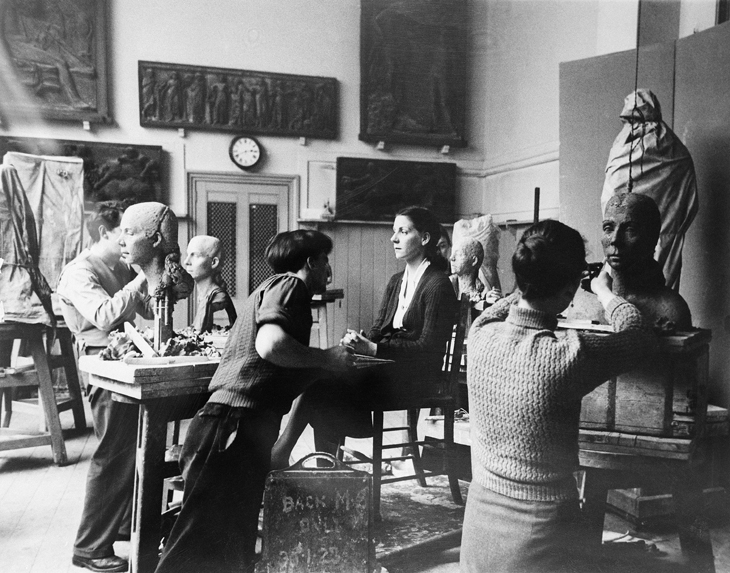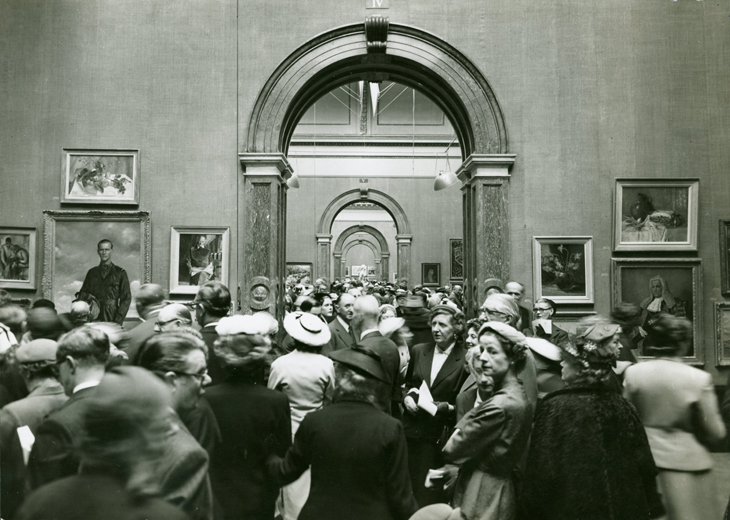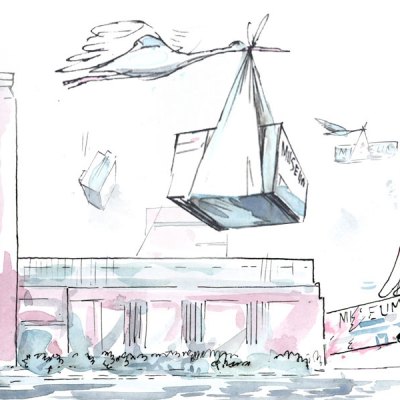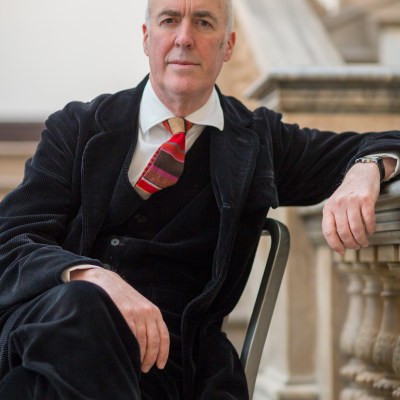The Royal Academy of Arts unveils its new-look buildings next week, as part of the celebrations of its 250th anniversary. Below, four figures associated with RA discuss what sets the institution apart. (See here for Secretary and Chief Executive Charles Saumarez Smith on the history of the redevelopment.)
Norman Rosenthal
Former Exhibitions Secretary at the Royal Academy of Arts from 1977 until 2008
It must have been in 1977, just around the time I got the job as Assistant Secretary (Exhibitions) at the Royal Academy, that I ran into the great Ernst Gombrich, well known as the author of The Story of Art. When I told him of my good fortune, he looked me up and down and said, in his inimitable Viennese accent: ‘Norman, I am so heppy for you – you will learn so much.’ Considering that I had never formally studied art or art history, those words were indeed true for me. But regarding the RA they have a much wider significance for all lovers of art.
For above all, art is there to be loved. This has surely been true for everyone connected to the Royal Academy of Arts, founded 250 years ago as an association of artists and architects to make possible a freely accessible art school for talented students – one still maintained, against all the odds. There is the Annual Exhibition too, of course, which, for all its obvious drawbacks in a modern world, is essentially there to promote the principle and value of contemporary art. Like all long-lasting institutions, the RA has had its ups and downs. But in its aims, if perhaps not absolutely always in its results, it has remained fundamentally true to its mission.
In 1868, when Burlington House, the great London residence of the Devonshire family, was transformed into a home for various learned societies, the RA moved from occupying one half of the premises of the National Gallery in Trafalgar Square to Piccadilly. Here the visual arts were granted great public prominence, with the Royal Academy given the most splendid and adaptable galleries in Burlington House. The horrible truth is that the 19th century was indeed the greatest age of sympathetic museum building: these galleries allow works of art, ancient and modern, a grandeur that makes them all – whether by by Mantegna or Damien Hirst, masterpieces of African art or paintings by Claude Monet – as happy as their viewers. This means that the RA is almost unique as an institutional venue for the display of art, enabling it, even now, to mount great exhibitions such as the recent show, ‘Charles I: King and Collector’. Its own historical holdings hardly suffice as trading chips for obtaining loans. Its only asset is its long-standing reputation, which now stretches back through those magical 250 years of showing art, in all its beauty and diverse splendours, in a great building – now about now to double in size, a great opportunity though not one without danger – in the very centre of London.
London truly remains one of the greatest cultural and creative cities on our planet. The Royal Academy of Arts is, to emphasise the point once again, an association of artists, who by definition love and understand art and what it can communicate for all of us.
Rebecca Salter
Keeper of the RA Schools
The Royal Academy of Arts is able to be what it is and do what it does because it has the luxuries of time and independence. In an era that trades on short-term attention, the Academy has the reassurance of its own history and the confidence of an institutional resilience built up over 250 years.
The constant tension between the constraints of an elegantly written set of laws and the wishes and ambitions of a group of independent-minded Royal Academicians has always made for a lively institution. At times that liveliness has turned in on itself, and the Academy has appeared out of step with an art world of which it is an important part. I think it is fair to say that, as we mark our 250th birthday, we are not only celebrating the enlargement of the Academy’s campus but also the growing diversity of the organisation and the ambition of its artistic and educational programmes.
As Keeper, I have stewardship of the Royal Academy Schools, which to this day embody the founding impulse of the Academy: to create an institution that holds at its heart the passing of knowledge from one generation to the next. The first Keeper, George Moser, was very clear that he envisaged a teaching model within the Schools that positively valued a multiplicity of voices. Concern that the effect could be confusing was tempered by a strong desire not to emulate the more rigid European academic model.
Students in the Royal Academy Schools (1953), Russell Westwood. Photo: courtesy Royal Academy of Arts, London; © the artist

Those early voices were provided by the Academicians; our voices now also include those of visiting artists and architects. As a result, the principles of dialogue and discourse are maintained and students are encouraged to find their own voices with which to argue, debate, agree or disagree. Our three-year postgraduate course (a rare thing today) above all else gives the student the opportunity to fail but, as Samuel Beckett suggested, ‘fail better’ within a supportive environment, and have time to recover. The ecology of the Academy is unique in having within it Academicians in their nineties and students in their twenties, all engaged in the same activity of getting better at what they do best. Where else could that happen? The Royal Academy is a living organism, and not merely an institution.
Nick Goss
Artist
Next year, it will have been 10 years since I graduated from the RA Schools – and I still have vivid memories of the place. In particular, of the morning routine: saying hi to one of the Red Collar guards manning the door, glancing up at the looming plaster cast of Laocoön and his Sons, depicting a Trojan priest entangled with sea serpents, and heading to the studios via the kitchen to pick up a super-strength black coffee.
The Schools offer a three-year course, with a small community of only 17 people in each year, creating an intense yet intimate atmosphere. Students get to know each other’s work closely, and actively encourage each other to take risks, to challenge the perceptions surrounding art and life with which they arrived. After school hours, most students and tutors would head out to the Back Door pub for a beer and a black sambuca and continue the day’s conversations. I enjoyed the fact that talk of galleries and the professional side of being an artist was kept to a minimum. Instead there was a fevered competitiveness among peers to make great original work that was somehow different from that of the other artists working alongside you.
Friendships are formed with peers and tutors during the three years that continue to blossom 10 years on. London can be a tough place to be an artist, with a lack of studios forcing us further and further into the hinterland of the city. As RA Schools alumni we help and support each other with studio visits, and by making work together and exhibiting together. Since graduating, I have always had a number of friends from the Schools working near me in the same studios, and now share a gallery (Josh Lilley Gallery) with a number of them. It is a testament to the charm and character of the Schools that this community has flourished since leaving the RA, and that it continues to develop.
Sarah Victoria Turner
Deputy Director for Research at the Paul Mellon Centre for Studies in British Art, London
On Wednesday 26 April 1769, in rented premises on Pall Mall in London, the first annual exhibition of the recently founded Royal Academy of Arts opened to the public. Small in size by the standards of today’s Summer Exhibitions – it included just 136 works – it was nevertheless ambitious in its purpose and boasted many of the country’s leading painters, sculptors and architects among its participants, including the first President of the Royal Academy, Sir Joshua Reynolds.
The Main Galleries during the Summer Exhibition, 1956. Photo: © Royal Academy of Arts, London

The event has witnessed numerous changes over its 250-year history, including the acquisition of its now revered name. It only became known as the ‘Summer Exhibition’ when ‘Winter’ loan exhibitions were introduced in 1870. However, it has remained strikingly loyal to its founding moment. The Academy’s Instrument of Foundation, issued in December 1768, declared that there was to be ‘an Annual Exhibition of Paintings, Sculptures and Designs, which shall be open to all Artists of distinguished merit’. The exhibition has grown in size, accommodated by the larger spaces of the Academy as it moved around central London, but in many ways this open-submission exhibition selected and hung by members of the Royal Academy retains many of the same features of that first exhibition of 1769.
The works of already famous artists have always jostled with works produced by numerous less well-known and amateur practitioners, creating the famously dense hang on the Academy’s walls and floors. The aesthetic friction of the Summer Exhibition, created by placing so many works in close proximity, is rarely seen elsewhere. Loved by some, loathed by others, the Summer Exhibition has long been an event that has attracted the attention of the public and press – both positive and negative.
This remarkably unbroken 250-year history makes the Summer Exhibition unique, affording it the accolade of being the longest continuously staged exhibition of contemporary art in the world. It has the potential to tell us much about the changing nature of aesthetic styles, artistic fashions and purchasers’ tastes – significantly, it has always been a selling exhibition, and an important source of income for artists and the Academy – as well as the fluctuating fortunes of the place of the Royal Academy in the British art world. The Summer Exhibition’s resilience is more than ever apparent in its 250th year; at the time of writing, the coordinator of the upcoming display, Grayson Perry, together with the Selection and Hanging Committees, is whittling down the many thousands of digital images submitted for consideration to an initial selection of 4,000 works that they will then judge directly.
Researching this long history is an overwhelming task and is why, perhaps, there has been no single attempt to reflect on the impact of the Summer Exhibition and its relationship to the broader national and international art histories of which it is a part. Over the last three years, I have been working with Mark Hallett and colleagues at the Paul Mellon Centre for Studies in British Art and at the Royal Academy to chart the history of the Summer Exhibition, frequently delving into the treasure-trove of the Academy’s Library, Archive and Collections. The results of this work will be presented this summer in an exhibition, ‘The Great Spectacle: 250 Years of the Summer Exhibition’ (12 June–19 August), an accompanying book, and also a free digital publication that gathers artwork, stories, and data relating to the 250 years of the exhibition’s history, accompanied by complete and searchable copies of the catalogue for each year. All these projects shine a light on the unique prism that the Summer Exhibition offers through which to view 250 years of art-making in Britain.
From the May issue of Apollo. Preview and subscribe here.


